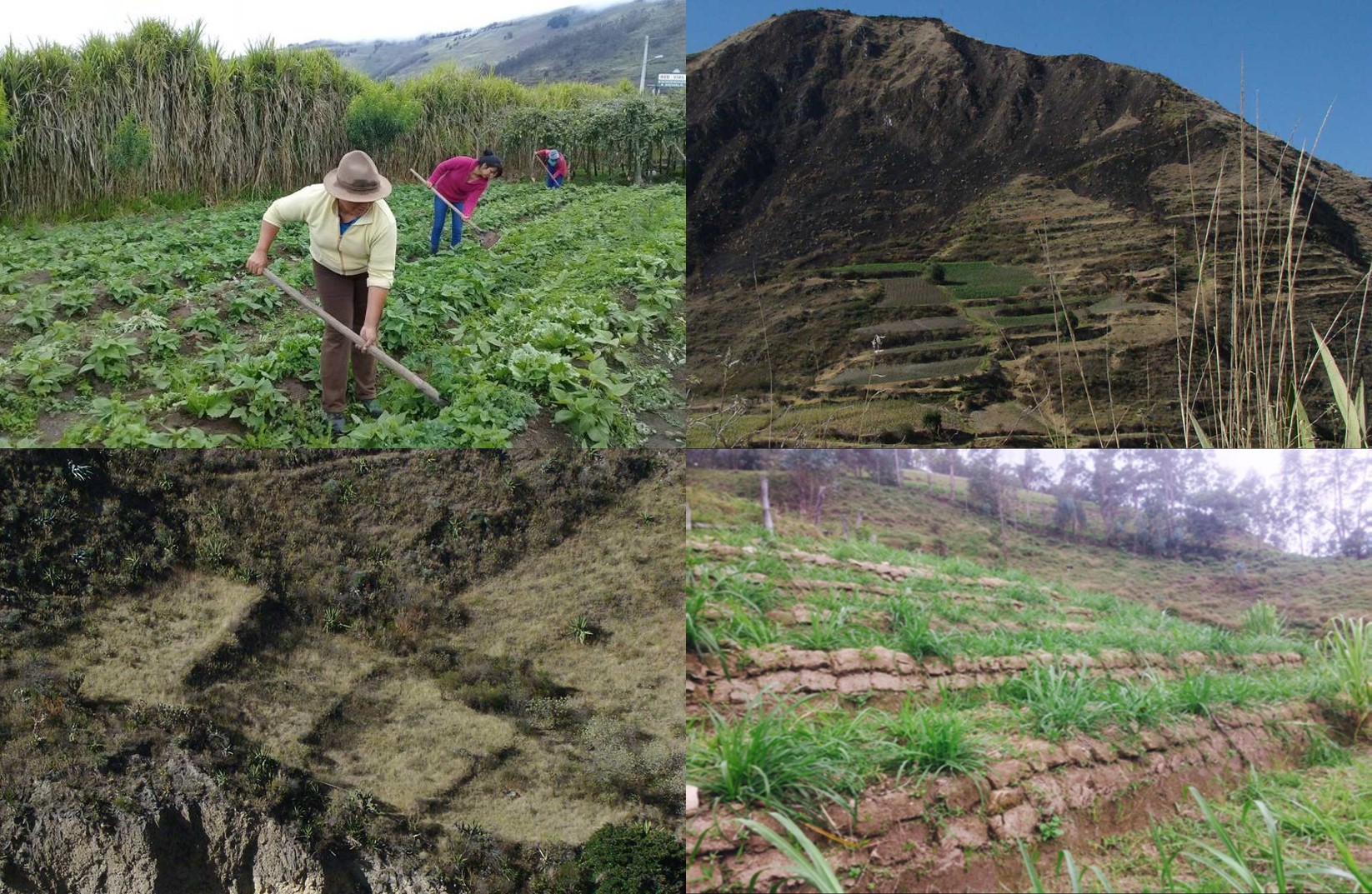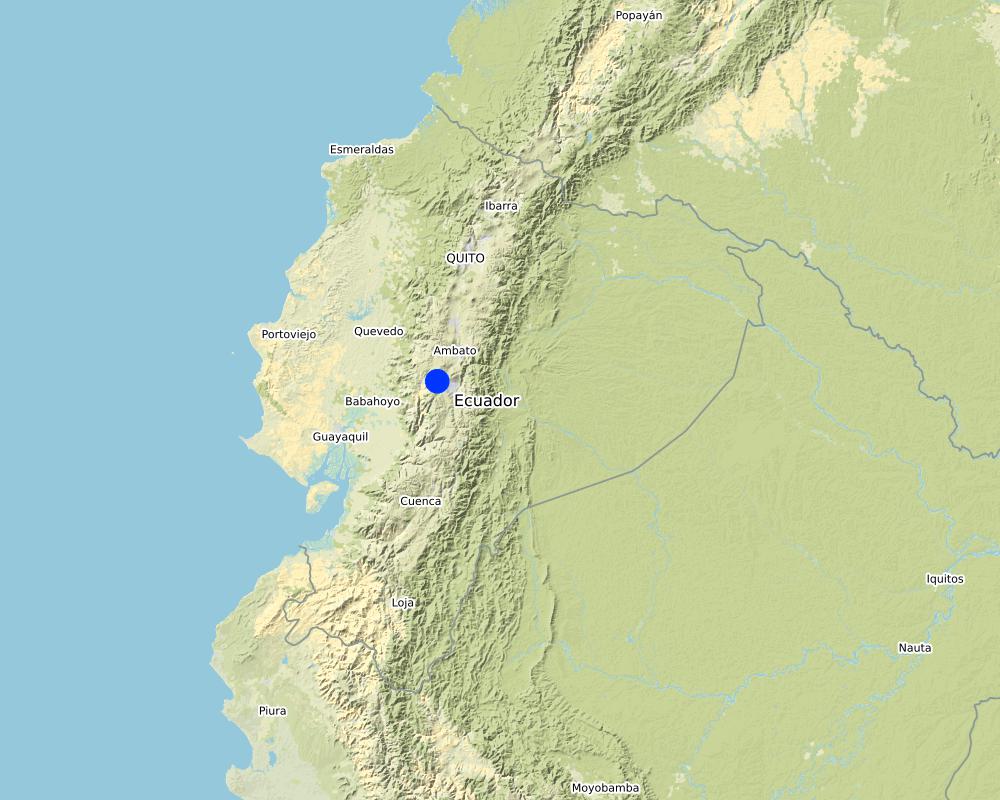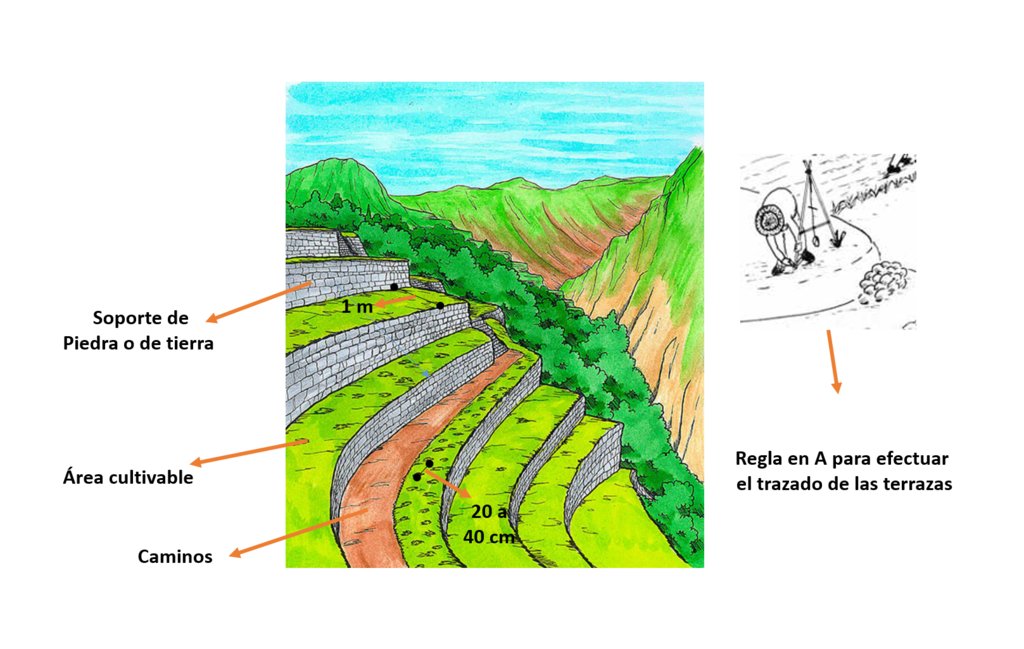Cultivos en terrazas [Ecuador]
- Creation:
- Update:
- Compiler: Pablo Caza
- Editor: Carlos Samaniego
- Reviewers: Giacomo Morelli, Nicole Harari, Johanna Jacobi
Cultivos en terrazas
technologies_3277 - Ecuador
View sections
Expand all Collapse all1. General information
1.2 Contact details of resource persons and institutions involved in the assessment and documentation of the Technology
Key resource person(s)
land user:
Jaramillo Sánchez Leonardo Alexander
+ 593 985812703
lj.forestal@hotmail.com
Ministerio del Ambiente y Agua del Ecuador (MAAE)
Ecuador
Jaramillo Sánchez Leonardo Alexander
+ 593 985812703
lj.forestal@hotmail.com
Ministerio del Ambiente y Agua del Ecuador (MAAE)
co-compiler:
Name of project which facilitated the documentation/ evaluation of the Technology (if relevant)
Decision Support for Mainstreaming and Scaling out Sustainable Land Management (GEF-FAO / DS-SLM)Name of the institution(s) which facilitated the documentation/ evaluation of the Technology (if relevant)
Ministerio de Ambiente y Agua Ecuador (MAAE) - EcuadorName of the institution(s) which facilitated the documentation/ evaluation of the Technology (if relevant)
Ministerio de Agricultura y Ganadería Ecuador (MAG) - EcuadorName of the institution(s) which facilitated the documentation/ evaluation of the Technology (if relevant)
Organización de la Naciones Unidas para la Alimentación y la Agricultura Ecuador (FAO Ecuador) - Ecuador1.3 Conditions regarding the use of data documented through WOCAT
When were the data compiled (in the field)?
20/11/2018
The compiler and key resource person(s) accept the conditions regarding the use of data documented through WOCAT:
Yes
1.4 Declaration on sustainability of the described Technology
Is the Technology described here problematic with regard to land degradation, so that it cannot be declared a sustainable land management technology?
No
2. Description of the SLM Technology
2.1 Short description of the Technology
Definition of the Technology:
Los cultivos de terraza es uno de los tipos más antiguos de manejo del suelo y de los recursos hídricos para la agricultura a gran escala.
Se conoce como cultivo en terrazas a la práctica de cortar un paisaje montañoso en zonas planas con el fin de producir cultivos. Una de las principales razones del uso de las terrazas de cultivo, ha sido para evitar la erosión del suelo, así como para canalizar el agua para el riego.
2.2 Detailed description of the Technology
Description:
Esta tecnología consiste en la construcción de terrazas en zonas con pendientes fuertes, generalmente en áreas montañosas donde la siembra convencional no es factible. Las terrazas se deben establecer con curvas de nivel para alcanzar mejores resultados en cuanto a drenaje del agua y distribución de la tecnología. En las terrazas se siembra cultivos, pastos o arbustos mismas que pueden estar distribuidas en hileras separadas unos 30 o 40 cm entre plantas dependiendo del ancho de la terraza. En las terreras se consideran también la siembra de especies con raíces profundas que permitan sostener la tierra que se desliza por la pendiente y labores culturales que realizan en el terreno. Una de las principales ventajas del cultivo en terrazas es que puede proteger el suelo de la zona de terraza de la erosión demasiado rápida. La erosión ocurre cuando el agua en movimiento elimina el suelo del área en la que fluye. Las terrazas, mediante la reducción de la longitud de la pendiente que el agua tiene para moverse (es decir, mediante la creación de una terraza a nivel en una cara inclinada), disminuyen el flujo de agua, esto evita que el suelo de la zona sea arrastrado en un diluvio. La incorporación de las técnicas demanda un importante esfuerzo técnico y económico, por lo que los conocimientos referentes a esta temática (Conocimientos ancestrales) son fundamentales para alcanzar buenos resultados. Este esfuerzo está dirigido a pequeños propietarios agrícolas y forestales de sectores semiáridos de nuestro país, y que tiene por objetivo el ofrecer nuevas tecnologías de conservación de aguas y suelos, que permitan actuaciones más acordes con el medio ambiente físico y social y que hagan posible acercarse hacia un desarrollo sostenible.
2.3 Photos of the Technology
2.5 Country/ region/ locations where the Technology has been applied and which are covered by this assessment
Country:
Ecuador
Region/ State/ Province:
Provincia de Chimborazo
Map
×2.6 Date of implementation
If precise year is not known, indicate approximate date:
- more than 50 years ago (traditional)
2.7 Introduction of the Technology
Specify how the Technology was introduced:
- through land users' innovation
- as part of a traditional system (> 50 years)
Comments (type of project, etc.):
Es una tecnología ancestral que contribuye a la conservación de los suelos. Ha sido implementada cientos de años atrás y ha perdido auge debido a los costos y al esfuerzo físico que requiere para implementarla.
3. Classification of the SLM Technology
3.1 Main purpose(s) of the Technology
- improve production
- reduce, prevent, restore land degradation
- conserve ecosystem
- reduce risk of disasters
- create beneficial economic impact
- create beneficial social impact
3.2 Current land use type(s) where the Technology is applied

Cropland
- Perennial (non-woody) cropping
- Tree and shrub cropping

Mixed (crops/ grazing/ trees), incl. agroforestry
- Agroforestry
- Agro-pastoralism
Main products/ services:
La tecnología puede acoplarse a cualquier tipo de cultivo, dependiendo de la necesidad del agricultor.
3.3 Further information about land use
Water supply for the land on which the Technology is applied:
- mixed rainfed-irrigated
Number of growing seasons per year:
- 2
3.4 SLM group to which the Technology belongs
- agroforestry
- integrated soil fertility management
- irrigation management (incl. water supply, drainage)
3.5 Spread of the Technology
Specify the spread of the Technology:
- evenly spread over an area
If the Technology is evenly spread over an area, indicate approximate area covered:
- < 0.1 km2 (10 ha)
Comments:
Dependiendo de la cantidad de mano de obra disponible se puede puede llegar a cubrir un área considerable.
3.6 SLM measures comprising the Technology

structural measures
- S1: Terraces
3.7 Main types of land degradation addressed by the Technology

soil erosion by water
- Wt: loss of topsoil/ surface erosion
- Wm: mass movements/ landslides
- Wr: riverbank erosion

physical soil deterioration
- Pc: compaction
- Pk: slaking and crusting

biological degradation
- Bq: quantity/ biomass decline
- Bl: loss of soil life
3.8 Prevention, reduction, or restoration of land degradation
Specify the goal of the Technology with regard to land degradation:
- prevent land degradation
- reduce land degradation
4. Technical specifications, implementation activities, inputs, and costs
4.1 Technical drawing of the Technology
Author:
Leonardo Jaramillo, técnico de la subsecretaría de Cambio Climático del Ministerio del Ambiente y Agua (MAAE) – Ecuador.
Date:
25/06/2020
4.2 Technical specifications/ explanations of technical drawing
Para construir una terraza se la debe mantener a nivel con una regla en A
Se pueden construir soportes de piedra, o únicamente se lo deja con el talud de tierra.
La distancia las terrazas depende, en muchos de los casos, de los cultivos que se van a sembrar. Generalmente tienen 1 metro de ancho y entre cultivos, si son hortalizas, se siembra de 20 a 30 cm entre cada planta.
Las terrazas son una manera excelente de aumentar el área cultivable de un huerto familiar a largo plazo
4.3 General information regarding the calculation of inputs and costs
Specify how costs and inputs were calculated:
- per Technology unit
Specify unit:
cultivos en terrazas
Specify volume, length, etc. (if relevant):
2500 metros cuadrados
Specify currency used for cost calculations:
- US Dollars
Indicate average wage cost of hired labour per day:
15
4.4 Establishment activities
| Activity | Type of measure | Timing | |
|---|---|---|---|
| 1. | Limpieza de terreno | Vegetative | inicio |
| 2. | Transporte de materiales | Structural | logistica |
| 3. | Preparación de terreno | Agronomic | implementación |
| 4. | Siembra de cultivos o arbustos | Agronomic | implementación |
| 5. | Riego y mantenimiento ( 6 meses) | Management | implementación |
Comments:
Un jornal equivale a un día de trabajo pagado a razón de 15 dólares.
4.5 Costs and inputs needed for establishment
| Specify input | Unit | Quantity | Costs per Unit | Total costs per input | % of costs borne by land users | |
|---|---|---|---|---|---|---|
| Labour | Limpieza de terreno | jornal | 4.0 | 15.0 | 60.0 | 100.0 |
| Labour | Transporte de materiales | jornal | 3.0 | 15.0 | 45.0 | 20.0 |
| Labour | Preparación de terreno (terrazas) | jornal | 40.0 | 15.0 | 600.0 | 50.0 |
| Labour | Siembra de cultivos o arbustos | jornal | 3.0 | 15.0 | 45.0 | 100.0 |
| Equipment | Riego y mantenimiento ( 6 meses) | jornal | 10.0 | 15.0 | 150.0 | 100.0 |
| Equipment | Mantenimiento de los cultivos | jornal | 3.0 | 15.0 | 45.0 | 100.0 |
| Equipment | Pala | unidad | 2.0 | 10.0 | 20.0 | 100.0 |
| Equipment | Barreta | unidad | 2.0 | 10.0 | 20.0 | 100.0 |
| Equipment | Vehiculo | flete | 2.0 | 15.0 | 30.0 | 100.0 |
| Plant material | Árboles frutales | planta | 25.0 | 3.0 | 75.0 | |
| Plant material | Semillas de hortaliza | kit | 5.0 | 10.0 | 50.0 | |
| Fertilizers and biocides | . | . | ||||
| Fertilizers and biocides | . | . | ||||
| Construction material | . | . | ||||
| Total costs for establishment of the Technology | 1140.0 | |||||
If land user bore less than 100% of costs, indicate who covered the remaining costs:
Proyectos de desarrollo sostenible implementados por la autoridad local o regional.
4.6 Maintenance/ recurrent activities
| Activity | Type of measure | Timing/ frequency | |
|---|---|---|---|
| 1. | Limpieza | Management | mensual |
| 2. | Acondicionamiento de terrazas | Structural | mensual |
4.7 Costs and inputs needed for maintenance/ recurrent activities (per year)
If possible, break down the costs of maintenance according to the following table, specifying inputs and costs per input. If you are unable to break down the costs, give an estimation of the total costs of maintaining the Technology:
219.0
| Specify input | Unit | Quantity | Costs per Unit | Total costs per input | % of costs borne by land users | |
|---|---|---|---|---|---|---|
| Labour | Limpieza | Jornal | 6.0 | 15.0 | 90.0 | 100.0 |
| Labour | Acondicionamiento de terrazas | jornal | 10.0 | 15.0 | 150.0 | 100.0 |
| Equipment | Machete | machete | 2.0 | 10.0 | 20.0 | 100.0 |
| Equipment | Pala | pala | 2.0 | 10.0 | 20.0 | 100.0 |
| Plant material | . | . | ||||
| Fertilizers and biocides | . | . | ||||
| Construction material | . | . | ||||
| Total costs for maintenance of the Technology | 280.0 | |||||
If land user bore less than 100% of costs, indicate who covered the remaining costs:
Generalmente los costos del material vegetativo y de los demás insumos son aportados por los proyectos de desarrollo sostenible. Los costos de adecuación y limpieza son asumido por los beneficiarios.
4.8 Most important factors affecting the costs
Describe the most determinate factors affecting the costs:
El factor más determinante en esta técnica es la mano de obra.
5. Natural and human environment
5.1 Climate
Annual rainfall
- < 250 mm
- 251-500 mm
- 501-750 mm
- 751-1,000 mm
- 1,001-1,500 mm
- 1,501-2,000 mm
- 2,001-3,000 mm
- 3,001-4,000 mm
- > 4,000 mm
Agro-climatic zone
- semi-arid
- arid
5.2 Topography
Slopes on average:
- flat (0-2%)
- gentle (3-5%)
- moderate (6-10%)
- rolling (11-15%)
- hilly (16-30%)
- steep (31-60%)
- very steep (>60%)
Landforms:
- plateau/plains
- ridges
- mountain slopes
- hill slopes
- footslopes
- valley floors
Altitudinal zone:
- 0-100 m a.s.l.
- 101-500 m a.s.l.
- 501-1,000 m a.s.l.
- 1,001-1,500 m a.s.l.
- 1,501-2,000 m a.s.l.
- 2,001-2,500 m a.s.l.
- 2,501-3,000 m a.s.l.
- 3,001-4,000 m a.s.l.
- > 4,000 m a.s.l.
Indicate if the Technology is specifically applied in:
- concave situations
5.3 Soils
Soil depth on average:
- very shallow (0-20 cm)
- shallow (21-50 cm)
- moderately deep (51-80 cm)
- deep (81-120 cm)
- very deep (> 120 cm)
Soil texture (topsoil):
- coarse/ light (sandy)
- fine/ heavy (clay)
Soil texture (> 20 cm below surface):
- coarse/ light (sandy)
- fine/ heavy (clay)
Topsoil organic matter:
- medium (1-3%)
5.4 Water availability and quality
Ground water table:
on surface
Availability of surface water:
medium
Water quality (untreated):
for agricultural use only (irrigation)
Is water salinity a problem?
No
Is flooding of the area occurring?
No
5.5 Biodiversity
Species diversity:
- medium
Habitat diversity:
- medium
5.6 Characteristics of land users applying the Technology
Sedentary or nomadic:
- Sedentary
Market orientation of production system:
- mixed (subsistence/ commercial
Off-farm income:
- less than 10% of all income
Relative level of wealth:
- poor
Individuals or groups:
- individual/ household
Level of mechanization:
- manual work
Gender:
- women
- men
Age of land users:
- middle-aged
- elderly
5.7 Average area of land owned or leased by land users applying the Technology
- < 0.5 ha
- 0.5-1 ha
- 1-2 ha
- 2-5 ha
- 5-15 ha
- 15-50 ha
- 50-100 ha
- 100-500 ha
- 500-1,000 ha
- 1,000-10,000 ha
- > 10,000 ha
Is this considered small-, medium- or large-scale (referring to local context)?
- small-scale
5.8 Land ownership, land use rights, and water use rights
Land ownership:
- individual, not titled
- individual, titled
Land use rights:
- leased
- individual
Water use rights:
- leased
- individual
5.9 Access to services and infrastructure
health:
- poor
- moderate
- good
education:
- poor
- moderate
- good
technical assistance:
- poor
- moderate
- good
employment (e.g. off-farm):
- poor
- moderate
- good
markets:
- poor
- moderate
- good
energy:
- poor
- moderate
- good
roads and transport:
- poor
- moderate
- good
drinking water and sanitation:
- poor
- moderate
- good
financial services:
- poor
- moderate
- good
6. Impacts and concluding statements
6.1 On-site impacts the Technology has shown
Socio-economic impacts
Production
crop production
Comments/ specify:
La producción de los cultivos en terrazas se incrementa debido al uso eficiente del agua.
crop quality
Comments/ specify:
La calidad se incrementa por las condiciones de espacio dispuestas en la ladera, considerando pendiente.
risk of production failure
production area
Income and costs
farm income
Socio-cultural impacts
food security/ self-sufficiency
Ecological impacts
Water cycle/ runoff
surface runoff
Comments/ specify:
Se reduce la escorrentía significativamente con el establecimiento de las tecnologías.
Climate and disaster risk reduction
landslides/ debris flows
6.2 Off-site impacts the Technology has shown
water availability
Comments/ specify:
Se realiza infiltración y mejor distribución del agua.
6.3 Exposure and sensitivity of the Technology to gradual climate change and climate-related extremes/ disasters (as perceived by land users)
Gradual climate change
Gradual climate change
| Season | Type of climatic change/ extreme | How does the Technology cope with it? | |
|---|---|---|---|
| annual rainfall | increase | well |
Climate-related extremes (disasters)
Hydrological disasters
| How does the Technology cope with it? | |
|---|---|
| landslide | very well |
6.4 Cost-benefit analysis
How do the benefits compare with the establishment costs (from land users’ perspective)?
Short-term returns:
positive
Long-term returns:
very positive
How do the benefits compare with the maintenance/ recurrent costs (from land users' perspective)?
Short-term returns:
positive
Long-term returns:
very positive
6.5 Adoption of the Technology
- single cases/ experimental
If available, quantify (no. of households and/ or area covered):
Son caso muy puntuales donde se implementa la medida
Comments:
de cada 50 personas, probablemente 2 implementen la tecnología. Es una tecnología con muchos beneficios ambientales pero demanda de muchos esfuerzo humano, por tanto no es muy aplicada por los agricultores.
6.6 Adaptation
Has the Technology been modified recently to adapt to changing conditions?
No
6.7 Strengths/ advantages/ opportunities of the Technology
| Strengths/ advantages/ opportunities in the land user’s view |
|---|
| La terraza aumenta la disponibilidad de agua en el perfil de suelo. |
| La terraza controla de la erosión suelo a causa del paso del agua (hídrica) |
| Se evita daños (deslizamientos) por cultivar en zonas con pendientes fuertes |
| Aprovechan de mejor manera los espacios espacios empinados. |
| Strengths/ advantages/ opportunities in the compiler’s or other key resource person’s view |
|---|
| Las terrazas permiten sostener la tierra que se desliza por la pendiente a causa de desprendimientos de tierra natural o por las labores agrícolas que realizan los agricultores. |
| Se conserva la humedad del suelos en las camas de las terrazas |
| Estabilización de pendientes con la siembra de especies de raíces profundas. |
6.8 Weaknesses/ disadvantages/ risks of the Technology and ways of overcoming them
| Weaknesses/ disadvantages/ risks in the land user’s view | How can they be overcome? |
|---|---|
| Mucho labor humana para poder establecerlos. | Mingas de trabajo comunitario. |
| Weaknesses/ disadvantages/ risks in the compiler’s or other key resource person’s view | How can they be overcome? |
|---|---|
| Establecer las terrazas demanda un importante esfuerzo técnico y económico | Proyectos con apoyo económico que permitan establecer la tecnología. |
7. References and links
7.1 Methods/ sources of information
- field visits, field surveys
4
- interviews with SLM specialists/ experts
3
7.2 References to available publications
Title, author, year, ISBN:
Manual de Conservación de aguas y suelos.
Available from where? Costs?
http://ctha.utalca.cl/Docs/pdf/Publicaciones/manuales/g_instructivo_terrazas.pdf
7.3 Links to relevant information which is available online
Title/ description:
AGRICULTURA DE LADERAS A TRAVÉS DE ANDENES, PERÚ
URL:
http://www.fao.org/tempref/GI/Reserved/FTP_FaoRlc/old/docrep/RLC1054s/rlc1054s.012.pdf
Title/ description:
MANUAL PRÁCTICO PARA CONSTRUCCIONES DE TERRAZAS AGRÍCOLAS
URL:
https://www.portalfruticola.com/noticias/2018/05/10/manual-practico-para-construcciones-de-terrazas-agricolas/
Links and modules
Expand all Collapse allLinks
No links
Modules
No modules






